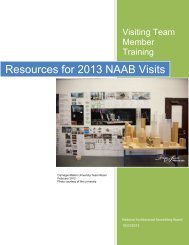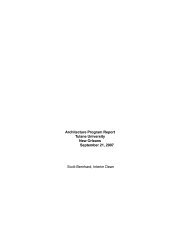NAAB Architecture Program Report (APR) 2013 - Tulane School of ...
NAAB Architecture Program Report (APR) 2013 - Tulane School of ...
NAAB Architecture Program Report (APR) 2013 - Tulane School of ...
Create successful ePaper yourself
Turn your PDF publications into a flip-book with our unique Google optimized e-Paper software.
<strong>Tulane</strong> University<strong>Architecture</strong> <strong>Program</strong> <strong>Report</strong>September <strong>2013</strong>Kenneth Schwartz, FAIA was appointed as dean in July 2008, increasing national and internationalrecognition for the extraordinary work <strong>of</strong> the school’s students, faculty, and alumni. In 2011, the <strong>School</strong>initiated its Master <strong>of</strong> Sustainable Real Estate Development <strong>Program</strong>. In 2012, the <strong>School</strong> launched anew university-wide undergraduate minor in Social Innovation and Social Entrepreneurship. In <strong>2013</strong>,Dean Schwartz was reappointed for a second five-year term.I.1.2.Learning Culture and Social EquityThe <strong>Tulane</strong> <strong>School</strong> <strong>of</strong> <strong>Architecture</strong> is unique in the way that fundamentals <strong>of</strong> architectural education areblended with extensive community engagement. These qualities have been present at the <strong>School</strong> formany decades, yet they have taken on greater focus, urgency, and momentum since Hurricane Katrinain 2005. The curriculum calibrates and celebrates these opportunities for students, and the progress, asseen through the work <strong>of</strong> students and faculty over the past eight years, has been impressive. The<strong>Tulane</strong> <strong>School</strong> <strong>of</strong> <strong>Architecture</strong> is nationally recognized for these qualities.All policies related to learning culture are available on the TSA website:http://architecture.tulane.edu/current-students/student-informationStudio CultureThe <strong>Tulane</strong> <strong>School</strong> <strong>of</strong> <strong>Architecture</strong> fully supports the studio-based model as central to the curriculum forarchitectural education and relies on the studio to provide and promote a healthy environment forcreative and engaged learning. The design studio is an open environment for fostering creativity andengagement in the design process, promoting exploration, innovation and intellectual advancement,and supporting a culture <strong>of</strong> critical inquiry, collaboration, community engagement, and stewardshipamong students, faculty and administration.Critical Inquiry: The design studio establishes the environment for the pursuit <strong>of</strong> knowledge within thediscipline <strong>of</strong> architecture, involving creative, intellectual and critical development. Design is a reflexiveprocess <strong>of</strong> individual creative thought and exploration combined with collective critical feedback throughdialogue among students and faculty. The open nature <strong>of</strong> the studio environment encouragesconsideration <strong>of</strong> a broad range <strong>of</strong> design possibilities pursued through analysis and experimentation. Instudio, the design process is open and accessible for the benefit <strong>of</strong> all, inspiring discussion, innovationand critical exchange. In turn, the open exchange <strong>of</strong> ideas fosters a creative and critical communityengaged in the advancement <strong>of</strong> knowledge with the highest academic and pr<strong>of</strong>essional standards. It isvital to the discipline <strong>of</strong> architecture that students are encouraged and have the capacity to engage theworld broadly. Design studio benefits from the influence and integration <strong>of</strong> information from broaderstudies, both within the <strong>School</strong> <strong>of</strong> <strong>Architecture</strong> and beyond. Reciprocally, methods <strong>of</strong> creativeengagement and critical analysis developed in studio become applied to the learning <strong>of</strong> materials inother courses as well as the world at large.Collaboration: <strong>Architecture</strong> is fundamentally a collaborative enterprise and a social art. It requireseffective forms <strong>of</strong> communication and the ability to consider and negotiate varying points <strong>of</strong> viewworking toward a common desired goal. An increased capacity for effective creative exchange isdeveloped as a part <strong>of</strong> the critical dialogue in studio among students and the faculty.Intrinsic to healthy collaboration is sensitivity for diversity <strong>of</strong> perspective, opinion, values and methods.Design studio requires a developed sense <strong>of</strong> respect, pr<strong>of</strong>essionalism and mutual support amongstudents and faculty. Open and thoughtful communication that respects all parties involved benefits thecollective environment and the individual. Competition, while fostered and necessary to the enterprise,does not supplant the centrality <strong>of</strong> the peer-to-peer learning process, nor should it ever compromise asupportive community <strong>of</strong> trust.3














